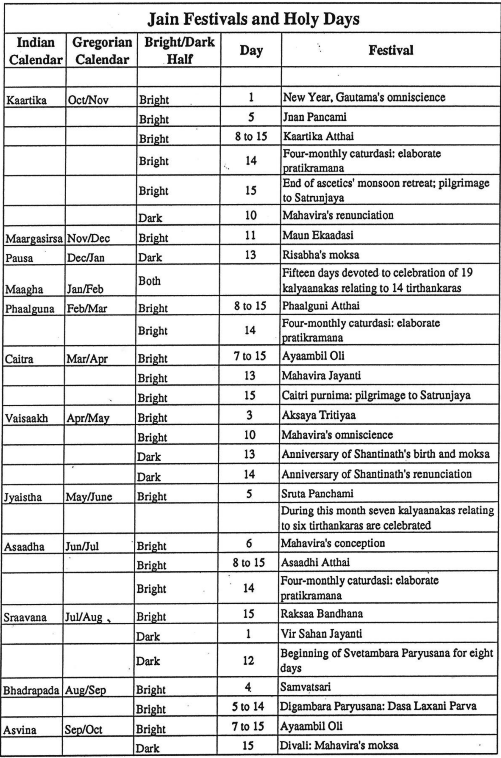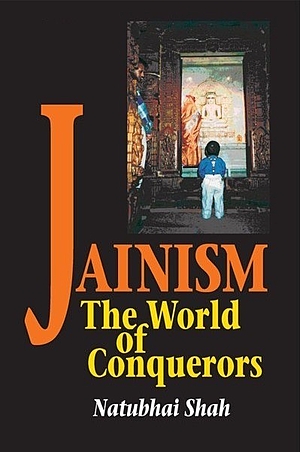Jainism has developed a sacred calendar that relates to particular individuals or events from the religious past, and certain periods of the year designated for spiritual observance. Although Jainism does not deny physical pleasures, Jain sacred days and festivals are noteworthy for the muted and restrained demeanour of the participants, and there is little of the extreme exuberance, enjoyment and entertainment, which often characterise Hindu festivals. The Jain festivals or sacred days are 'celebrated' by renunciation, austerities, the study of the scriptures, the recitation of hymns, meditation and devotion to the tirthankaras. Even those who are busy with daily life, like to be free from worldly entanglements and spend time in worship and meditation during these sacred days. In addition to spiritual objectives, these sacred festivals serve to raise money for the temples and other Jain institutions, and for human, animal and environmental welfare.
The regular festivals of the Jain year follow the traditional Indian calendar. Each Indian month is divided into the bright half (when the moon is waxing) and the dark half (when the moon is waning). The year is often numbered according to the Vikrama Samvat era (abbreviated V.S.) which commenced in 57 BCE or, in Jain circles, according to the Vira Samvat, commencing with Mahavira's moksa in 527 BCE.
The table 5.8 shows the most important dates in the Jain calendar, including the five auspicious occasions (kalyanakas) in the life of each tirthankara (conception, birth, renunciation, omniscience, and liberation), which are observed by fasting, semi-fasting or other religious activities. Although more than one commemoration may fall on the same day, they are too numerous for all to be included here. In addition, pious Jains fast partially or totally on the 2nd, 5th, 8th, 11th and 14th day of each half-month, or engage in other religious activities, as they believe that the span of the next life is decided every third day, so they show particular piety on those days. Most Jains observe fifth day of bright half and eighth and fourteenth day both bright and dark half as sacred days and would avoid harming even plant life on those days.
Jain festivals may be broadly divided into five classes: periodical, kalyanakas, historical, local and special. Periodic are the above sacred days, ayambil olis, the paryusana and three astanhikas; the kalyanakas are the auspicious occasions of the lives of tirthankaras; historic are the anniversaries and events of traditional significance; local are festivals of local in nature, such as the ceremonies of dwajaarohan, mastakaabhiseka, and ratha yaatra; and special are pratisthaa and pujaas such as the panca kalyaanaka and siddhacakra pujan.
Many of these festivals are celebrated with festivities and zeal. Places of worship are cleaned, decorated and given a fresh look; processions take place; dancing, singing and music are organised, community dinner is arranged and rejoicing takes place to mark the occasion. But religious and pious aspects of the occasions are always kept in mind. The Jain festivals are usually of spiritual in nature. Observing fasts, worshipping Jina and other adorable ones, recitation of hymns and sacred texts, pujaas, religious discourses, alms giving, taking vows and other acts of piety form part of the celebration of Jain holy days.
Table 5.8 The Jain Calendar

Jain Festivals and Holy Days
Paryusana Parva, an eight-day festival that falls in the months of August or September, is the most important period in the Jain calendar. The word paryusana is derived from two words meaning 'a year' and 'a coming back': it is a period of atonement and repentance for the acts of the previous year, and of austerities to help shed accumulated karma. During this period, some people fast for the whole eight days, some for shorter periods, the scriptures prescribe a minimum of three days, but it is considered obligatory to fast on the last day of paryusana. Fasting usually involves complete abstinence from any sort of food or drink, but some people do take boiled water during the daytime.
There are regular ceremonies in the temple and meditation hall. Over the first three days, sermons are given concerning one's obligations during paryusana, and the yearly and lifelong duties. From the fourth day onwards, the Kalpa Sutra, which includes a detailed account of Mahavira's life, lives of other tirthankaras and of Mahavira's disciples, is read to the congregation. On that day, the Kalpa Sutra receives special reverence and may be carried in procession to the home of a member of the community, who has made a generous donation in recognition of that honour, where it is worshipped all night with religious songs. On the fifth day, at a special ceremony, the auspicious dreams of Mahavira's mother are enacted; the birth of Mahavira is read from the Kalpa Sutra; and on hearing of the birth the devotees rejoice by singing and dancing, break coconuts and distribute the pieces among the congregation. As a symbol of the baby Mahavira, a coconut shaped silver representation is put in a cradle; the donor rocks it and the community sings a traditional cradlesong for this joyous occasion. Then the cradle is taken in procession to the donor's house and the community members rejoice by singing devotional songs and hymns till late at night.
Listening to the Kalpa Sutra, taking positive steps to ensure that living beings are not killed (perhaps by paying money to butchers to cease slaughtering), showing amity to fellow Jains, forgiveness to all living beings, austerity, and visiting neighbouring temples, these are the important activities undertaken during this festival. In some areas the Antakriddasaa Sutra is also read to motivate the laity to perform meritorious deeds.
The final day of paryusana, known as samvatsari, is the holiest day of the Jain calendar. Jains seek forgiveness from all living creatures for any harm, which they have caused, knowingly or unknowingly, and forgive those who have harmed them saying micchami dukkadam. A yearly elaborate penitential retreat (samvatsari pratikramana) is performed on this day. It is regarded important for one's spiritual life, not to harbour any ill will beyond the space of one year. Shortly after paryusana it is the custom to organise a community dinner (svami vaastalya) at which all Jains are welcome and dine together, regardless of their social position.
Digambars commence their paryusana, known as the 'sacred days of the ten spiritual qualities' (dasalaksana parva), immediately after the completion of the Svetambar paryusana. It lasts for ten days and revolves around the exposition of the ten chapters of the Tattvartha Sutra. Each of the ten days is observed in contemplation on one spiritual quality of the soul, namely: forgiveness, gentleness, straightforwardness, contentment, truth, restraint, austerity, renunciation, non-attachment and chastity. The congregation listens to the discourses and performs religious observances. The most auspicious day is ananta caturdashi, the last day, which is associated with the fourteenth tirthankara Anantanatha. On this day devotees fast and pujaa is performed with fourteen flowers. On the final day people seek and grant forgiveness. The festival concludes with a dinner.
Divali is a most important Jain festival, common to most Indian (especially north Indian) communities that falls in October or November. It marks the anniversary of the liberation of Mahavira and the attainment of omniscience by his chief disciple, Gautama Indrabhuti. Jains celebrate the Divali as a festival for five days: dhan teras, kaali chaudas, Divali, New Year and bhai beej, both as holy days and as a community festival. Traditionally, the festival commences with the worship of the goddess Laxmi on dhan teras. The next day is kaali chaudas when the recitation of Mahavira's last sermon, the Uttaraadhyayana Sutra, takes place, for it was then that Mahavira commenced his last sermon which was to last until he attained liberation, late into the night of Divali. Some Jains meditate in secluded places on this day in order to acquire superhuman accomplishments. It is also popular to worship the wish-fulfilling deity Gantakarna Mahavira on this day. (He is not, of course, to be confused with tirthankara Mahavira).
Then comes the day of Divali, when Mahavira ended his worldly life and attained moksa. Lights are lit as a symbolic representation of knowledge to be retained. Some devout Jains fast on the day preceding Divali and on Divali itself, as did Mahavira. Some perform ritualistic pujaas and worship the goddess of learning, Sarasvati. The next day is the first day of the New Year, the day of the enlightenment of Gautama when people listen to nine holy sutras (nava smaranas), and the epic poem Gautama Raasa. The fifth day of the festival is bhai beej, when sisters invite brothers to their homes, commemorating the invitation by Sudarshana to her brother Nandivardhana to comfort him for the loss of their brother Mahavira.
Jains also celebrate Divali as a community festival, with the lighting of lights and festive meals. At this time, Jain businessmen close the old year's accounts and open new ones, with accompanying traditional rituals. They offer gifts to children, family members and employees. New Year cards are sent to friends and relatives.
Jnaana Pancami is a sacred day observed on the fifth day after Divali for the worship of scriptural knowledge. On this day fasting, veneration of the tirthankaras (deva vandan), holy recitations and auspicious meditation are performed, and the sacred texts preserved in religious libraries are cleaned and worshipped.
Kaartika Purnimaa: This day is observed on the fifteenth day after Divali. After this day, the Jain ascetics, who have retired for the monsoon retreat, begin their wanderings again. On Kaartika purnimaa, many Jains go on pilgrimage to Satrunjay. For the benefit of devotees who cannot make the journey, large paintings of Satrunjay are displayed for worship in local temples. This day is also celebrated as the birthday of Aacaarya Hemacandra, the great scholar ascetic of the twelfth century CE, and the birthday of Srimad Rajcandra, the nineteenth-century saint.
Maun Ekaadasi: This important day of one hundred and fifty auspicious events relating to the tirthankaras falls in December, and is observed by the devotees in total silence, fast, meditation and listening to sermons.
Mahavira Jayanti: The birthday of Mahavira is celebrated in April, with a grand chariot procession, public functions, and enactment of his life and message; it is a public holiday in India. A magnificent celebration takes place on this occasion at his birthplace at Ksatriya Kunda, Vaisali, in Bihar.
Ayambil Oli: The semi-fasting austerity of ayambil oli occurs twice a year, in April (Caitra) and October (Aaso), for nine days. Devotees listen to the epic story of Shripal and Mayanasundari, and worship the nava pada, i.e. the pancha parmesthis, the Three Jewels and the austerities.
Akshaya Tritiya: Following the example of Risabhdeva, some perform the austerity of varsi tapa, described in chapter 2.0, and break the fast on the auspicious day of akshay tritiya (sometime in May), at Satrunjay or Hastinapur. Offering food and other necessities to the ascetics by the devotees on this special day is considered a pious act.
Saanta Pancami: This Digambar festival is celebrated in May/June to commemorate the day when the first Digambar canonical scripture was put into writing by Aacaaryas Puspadant and Bhutabali in 150 CE. It is observed as a day of veneration of the scriptures, emphasising the history and the importance of preserving Jain texts and scriptures. Raksaa Bandhan: This festival is celebrated in July/August along with discourses on the legendary story of Vishnukumar Muni, reminding the people the duty of the strong to protect the weak. Vir Sasan Jayanti: This sacred day commemorates the first sermon of Mahavira after attaining omniscience, and the establishment of the fourfold order (sangha). Astaanhika Mahotsava is festival of eight days that occurs thrice a year in October/November, March/April and July/August. According to the traditional belief celestial beings celebrate this eternal festival at the nandyavarta temples, described in Jain geography. During these sacred eight days, fasting, narrative recitals concerning the Three Jewels and austerities take place, and ritualised worship is performed with mystical diagrams before the images. Atthai Mahotsava: This eight day festival of ritualistic pujaas, recitations and community gatherings can take place on any auspicious occasion such as an installation ceremony.
Pratisthaa: This is the ceremony of installing images of the tirthankaras in a newly built or renovated temple. Among Svetambars, anjana salaakaa is performed as a consecration ritual before the installation of the image takes place, while Digambars perform the panca kalyanaka ritual for the consecration of an image. The installation ceremony lasts from three to sixteen days with elaborate rituals and pujaas, including reenactments of the lives of the tirthankaras. The piety of these occasions attracts devotees from far and wide, including ascetics who may travel (on foot) for months to attend. Installation ceremonies attract many donations from devotees. On each day of the ceremony there is a communal dinner. Fifteen thousand people attended the installation ceremony at the Jain Centre Leicester in the United Kingdom in 1988,
Panca Kalyanaka Mahotsava: Digambar ritualists perform the consecration with the panca kalyanaka of the images by re-enacting the conception, birth, renunciation, omniscience and moksa of tirthankaras. The installation ceremony follows immediately.
Dwajaarohana: On the anniversary of an installation ceremony the old flag is taken down and a specially decorated and venerated new flag is hoisted on to the spire of the temple. A special ritual consisting of seventeen forms of pujaa is undertaken on this day. The whole community celebrates this occasion and takes part in the community dinner. This long pennant-shaped flag, often red and white, which is changed every year, is a distinguishing emblem flying over many Jain temples in India
Ratha yaatra: This ceremony involves taking the image of the tirthankara in a 'chariot', in procession along the main roads of the city or town, accompanied by musicians and by thousands of devotees, including ascetics. Sangha Yaatra: This is a barefoot pilgrimage to the holy places by hundreds of devotees from the fourfold order. Along the way in towns and villages, fellow Jains welcome the pilgrims; ascetics who are among the pilgrims preach sermons; and the wealthy pilgrims donate to local temples. During this spiritual journey, six rules should be scrupulously observed: pilgrims should travel on foot and barefoot; they should desist from sensual and carnal pleasures; they must eat food only once a day; they should avoid consuming raw or green vegetables; they must sleep on a mat on the ground and should not sleep on a bed or a mattress; and pilgrims must observe a vow of righteousness. A family normally sponsors the Sangha yatra; the family members and relatives take care of each pilgrim personally. One, or more, member(s) of the family will fast in rotation on each day of the pilgrimage. Pujaa, sermons, recitations and rituals are the daily activities. At the end of the pilgrimage, the sponsor gives a gift to each pilgrim. It is the practice to award the title of Sanghavi to the pilgrimage sponsor, who is honoured by placing a garland around his neck (maalaaropana), and the honour of placing the garland goes to the highest bidder who offers a donation to the temple.
Mastakaabhiseka: Every twelfth year, in Sravanbelgola, Karnataka, the colossal image of Bahubali standing upright, unclothed and meditating, fifty-seven feet high (over seventeen metres) and carved from solid rock, has its head anointed. The veneration of this thousand-year-old image is of particular importance to Digambars who revere Bahubali as the first Jain to attain moksa in our age. Thousands of Jains of all sects come to take part in the ceremony, which lasts several weeks. For the ceremony, scaffolding is erected around the huge statue, to facilitate the devotees to anoint it by pouring sacred liquids over the image. The last head anointing ceremony took place in 1993. Saadharmika Vaatsalya: At the conclusion of most sacred days and festivals in the Jain calendar and on many auspicious occasions, a community dinner (sādharmika vaatsalya) is organised. It is also called Navakarasi ('dinner for those who recite the Navakara') and is considered as a pious act for the family who sponsors it. (Kalpa Sutra 1972, Bhadrabahu Muni 1986: pp.89-101, Jain J. 1983: pp.119-124)
 Dr. Natubhai Shah
Dr. Natubhai Shah
